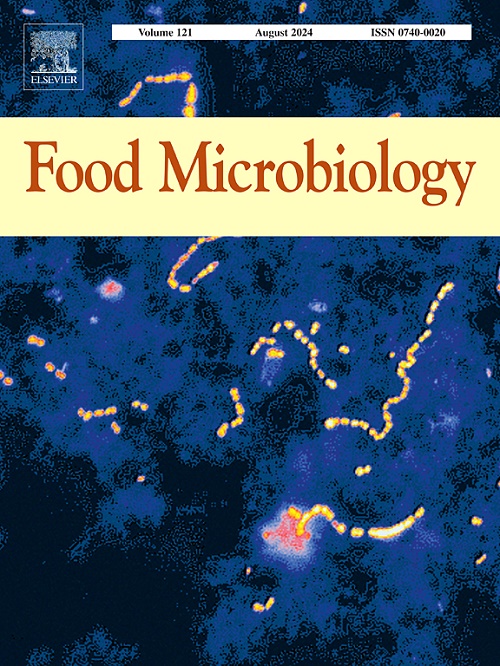酿酒酵母安第斯chicha分离株的遗传预适应促进了工业啤酒厂的应用
IF 4.5
1区 农林科学
Q1 BIOTECHNOLOGY & APPLIED MICROBIOLOGY
引用次数: 0
摘要
从厄瓜多尔传统生产的安第斯玉米基奇哈中分离出酿酒酵母菌株,并对其在工业啤酒酿造中的潜在用途进行了表征。全基因组测序显示,这些菌株与“法属圭亚那”和“墨西哥龙舌兰”S. cerevisiae分支有关,尽管现有证据表明它们属于以前未被描述的种群,因此与传统的欧洲酿造菌株无关。对麦汁发酵的小规模筛选发现了两株具有酿造潜力的菌株。这些菌株表现优于商业参考酿造菌株,其发酵特征和酒精产量与Mosaic/Beer 2组的酿酒酵母菌株相似。事实上,这两种菌株都具有STA1基因的功能拷贝,该基因负责细胞外葡萄糖淀粉酶活性,在Beer 2组的非原状成员中可见。序列鉴定表明,chicha菌株和Beer 2菌株尽管基因组不同,但具有相同的STA1基因,提示可能存在古代混合。中试酿造试验证实了chicha菌株发酵麦汁的潜力。啤酒的特点是高浓度的水果酯和丁香状化合物4-乙烯愈创木酚,这两者都是小麦啤酒和相关风格的典型特征。感官试验进一步证实了这些菌株酿造啤酒的潜力,在相同条件下,与商业小麦啤酒菌株生产的啤酒相比,啤酒更有优势。除了被认为是小麦啤酒中必不可少的风味化合物的4-乙烯愈创木酚外,在测试啤酒中没有检测到异味。结果强调了评估与传统谷物发酵相关的非欧洲菌株的工业酿造潜力的价值。本文章由计算机程序翻译,如有差异,请以英文原文为准。
Genetic pre-adaptations in Saccharomyces cerevisiae Andean chicha isolates facilitate industrial brewery application
Strains of Saccharomyces cerevisiae were isolated from a traditionally produced Andean maize-based chicha from Ecuador and characterised with respect to their potential use in industrial beer brewing. Whole-genome sequencing revealed that the strains were related to the ‘French Guiana’ and ‘Mexican Agave’ S. cerevisiae clades, though the available evidence indicates that they belong to a previously undescribed population, and are thus unrelated to traditional European brewing strains. Small-scale screening for wort fermentation revealed two strains with brewing potential. These outperformed commercial reference brewing strains and had fermentation profiles and alcohol yields similar to those of diastatic S. cerevisiae strains of the Mosaic/Beer 2 group. Indeed, both strains possessed functional copies of the STA1 gene responsible for extracellular glucoamylase activity seen in diastatic members of the Beer 2 group. Sequence identity suggested that the same STA1 gene is shared by the chicha and Beer 2 strains despite their genomic dissimilarity, suggesting the possibility of ancient admixture. Pilot-scale brewing trials confirmed the wort fermentation potential of the chicha strains. Beers were characterised by high concentrations of fruity esters and the clove-like compound 4-vinylguaiacol, both of which are typical features of wheat beers and related styles. Sensory trials further confirmed the potential of these strains for brewing, with beers comparing favourably to one produced with a commercial wheat-beer strain under the same conditions. Apart from 4-vinylguaiacol, which is considered an essential flavour compound in wheat beers, no off-flavours were detected in test beers. Results highlight the value of assessing industrial brewing potential of non-European strains associated with traditional cereal-based fermentations.
求助全文
通过发布文献求助,成功后即可免费获取论文全文。
去求助
来源期刊

Food microbiology
工程技术-生物工程与应用微生物
CiteScore
11.30
自引率
3.80%
发文量
179
审稿时长
44 days
期刊介绍:
Food Microbiology publishes original research articles, short communications, review papers, letters, news items and book reviews dealing with all aspects of the microbiology of foods. The editors aim to publish manuscripts of the highest quality which are both relevant and applicable to the broad field covered by the journal. Studies must be novel, have a clear connection to food microbiology, and be of general interest to the international community of food microbiologists. The editors make every effort to ensure rapid and fair reviews, resulting in timely publication of accepted manuscripts.
 求助内容:
求助内容: 应助结果提醒方式:
应助结果提醒方式:


